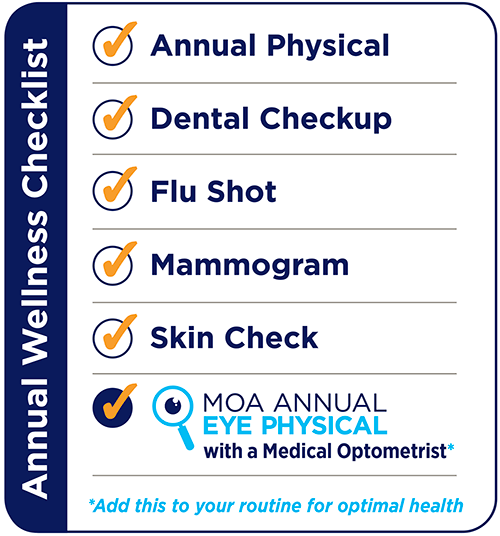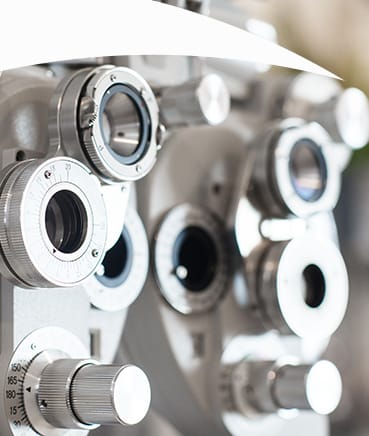Annual Eye Physical
Not all Eye Exams are Created Equal
The MOA Annual Eye Physical is the first-of-its-kind, comprehensive medical assessment of your visual and ocular health. It’s a more proactive way to stay on top of your eye care and protect your vision long-term.
Many eye diseases develop without any symptoms until the eye has already suffered vision threatening damage. Even with perfect vision, you could still have undetected eye disease. That’s why you need an eye exam that goes far beyond vision correction.
The medically-focused MOA Annual Eye Physical (AEP) helps detect, diagnose, treat, and manage potential issues before they become serious problems. The AEP:
- Starts with vision check and eye exam and provides a prescription for glasses if needed
- Goes beyond the basics with advanced diagnostic tests and imaging to find and treat problems at their earliest stages
- Establishes a critical baseline of your current eye health to support a lifetime of healthy vision
- Analyzes your risk for eye diseases and other health issues
- Documents our findings with an AEP Report Card to track your changes over time
At MOA, our eye doctors are Medical Optometrists who have received extensive additional training. Our Eye Health Centers are the most advanced facilities of their kind. We focus on primary medical eye care for the long-term health of your eyes.
An Essential Part of Your Wellness Routine
Just as we need an annual physical exam to thoroughly check out our bodies, we need an Annual Eye Physical to thoroughly examine our eyes. Our eyes are an extension of the central nervous system and provide the only direct view into our circulatory system. That’s why the AEP can catch many other health conditions such as heart disease, diabetes, arthritis, and even cancer, and in addition to eye diseases.
MOA’s Annual Eye Physical (AEP) is recommended for all adults and school-aged children, especially if you have a family history of eye disease or diabetes. The AEP is customized by lifestage to address the visual demands and the changing disease risks that evolve over a lifetime:
- Pediatric / adolescent
- Early adulthood
- Middle Age
- Mature adults
Even if you have perfect vision, there’s so much more to your eye health. Unfortunately, many eye diseases and conditions develop without any noticeable symptoms until the eye has already sustained significant damage.
After each Annual Eye Physical, patients receive a personalized Report Card providing a comprehensive overview of their eye health status. Patients also receive information on the state and progression of any eye diseases or conditions they have, along with treatment recommendations.



How Often Should I Have an Eye Physical?
Your medical optometrist eye doctor is the best person to ask about your eye exam schedule since only they are familiar with your unique visual needs and potential concerns. However, the American Optometric Association provides general guidelines for when the average low-risk patient should have their eyes examined. Most adults should have their eyes examined at least once a year.
Most children should have eye exams once at 6 months old, once at 3 years old, once when they start school, and once every year after that until they reach adulthood.
The MOA Annual Eye Physical Includes
Step 1: Medical and Ocular History Review
The MOA Annual Eye physical begins with a comprehensive review of your eye health history, your personal lifestyle, and your unique visual needs. This assessment is customized based on your life stage and will include your medical history, any previous or ongoing challenges with your eyes, the demands your daily life places on your vision including digital screen usage, and any questions or concerns you may have. All these things are assessed because they can have an effect on the health of your eyes.
Step 2: Vision Evaluation and Glasses Prescription
Your MOA medical optometrist will take you through various tests to evaluate how effectively your eyes can gather information and how well your brain can interpret that information. Some of the tests we perform include:
- Visual acuity: determining the clarity of your vision
- Visual fields screenings: identifying any “blind spots” you may have
- Binocular vision assessment: evaluation of how your eyes work together for optimal vision
- Auto-refraction: gaining a general idea of your prescription
- Refraction: finetuning and confirming your exact prescription
If needed, your MOA doctor can provide you with a prescription for glasses which you can take to your local optical shop, a general optometrist, or use with an online retailer.
Step 3: Advanced Diagnostic Testing & Tracking Over Time
A unique feature of the MOA Annual Eye Physical is that it evaluates your total eye health by using a series of advanced diagnostic and imaging tests, the same tests that are used to monitor patients with existing disease. By taking this proactive approach, these specialized tests provide our doctors with important information about your eyes that they cannot otherwise see in a routine exam. They not only assess the status of your eye health, but they also establish an important baseline to help catch eye diseases and conditions at the earliest moment and monitor any changes over time, well before you ever notice any changes in your vision. This is critical because many eye diseases are treatable when detected early.
Some of the diagnostic eye health tests we conduct include:
- Retinal photography: photo documenting diabetic eye disease, macular degeneration, and other retinal conditions
- Optical coherence tomography (OCT): 3-dimensional mapping of the retina, macula, optic nerve, and blood vessels
- Meibomian gland imaging: evaluates the gland function to assess potential issues and contribution to dry eye disease
The specific tests recommended for you will vary depending on your age and our findings in the first two steps.
Step 4: Eye Disease Risk Assessment
Most eye diseases start without obvious symptoms and by the time you notice something, the damage may already be done. Fortunately, with advanced diagnostic testing and regularly scheduled Annual Eye Physicals, your MOA medical optometrist will be able to assess and monitor your risk for the full range of eye diseases and conditions, and provide a personalized plan to help reduce your risk.
Beyond the thorough eye health examination, the MOA Annual eye physical can also provide an “early warning” window to your overall physical health. Long before many health conditions develop noticeable symptoms, there are early markers that can be identified through a comprehensive visual and ocular health examination. That’s because the eyes are an extension of the central nervous system and provide the only direct view of the circulatory system. Studies have found that these specialized eye health physicals can help identify up to 260 different systemic diseases, including multiple sclerosis, risk for a stroke, diabetes, thyroid disease, among others. The MOA AEP will create greater peace of mind, taking the extra preventative step to help ensure your total health and wellness.
Step 5: Personalized Report Card of Findings
Upon completion of your MOA Annual Eye physical, your MOA medical optometrist will discuss any areas requiring management or improvement and create a personalized plan to optimize your eye care. They will also provide you with customized recommendations for specific things you can do to improve both your eye health and overall wellness. All your findings and recommendations will be captured in an MOA AEP Report Card which provides a concise summary of everything discussed and enable your MOA doctor to track your progress over time.
Common Annual Eye Physical Questions
Do I need an AEP even though I am already being treated for another eye condition?
While you may come to MOA to receive treatment for a specific condition or eye injury, it is still important to schedule your AEP. Just as seeing your family doctor for a sore throat or minor injury doesn’t mean you can skip your annual physical, being seeing for a specific eye health concern does not replace the Annual Eye Physical. The AEP gives patients a proactive solution to monitoring and maintaining total eye health.
Is the AEP covered by insurance?
If you have a documented history of eye disease, a portion of the AEP may be covered by medical insurance. The screenings and imaging conducted will require out-of-pocket costs, which the MOA team will detail for you in advance. The testing conducted during the AEP offers significant value in providing a baseline of your eye health. It offers the MOA team the ability to track your risk for or status of undetected eye disease over time and is an important part of protecting your vision and eye health.
The AEP is not covered by vision plans, which are focused on the cost of glasses and contacts.
What do MOA patients think of the AEP?
Many patients tell us ‘This is the most comprehensive eye exam I have ever had’ and are impressed by and appreciative of the AEP Report Card summary they are given at the end of exam. The Report Card helps us monitor your baseline status and risk for eye disease and conditions as we take a collaborative approach to maximizing your eye health.
Why Do I Need an Eye Physical?
Your eye health plays a large role in your overall health. Sometimes eye exams can detect underlying systemic problems like high cholesterol and high blood pressure. Just as you have an annual physical, you should have an annual eye exam.
Even if you have perfect vision, there could be more to your eye health than you realize. Unfortunately, many eye diseases and conditions develop without noticeable symptoms until the eye has already sustained significant damage, which can cause permanent vision loss.
Seeing your Medical Optometry America optometrist regularly allows them to track any changes to your eye health and vision. Annual eye exams provide opportunities to detect, diagnose, and treat or manage potential issues before they become serious problems.
